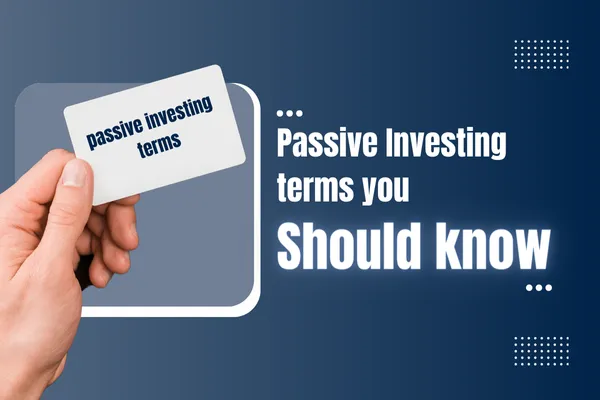Investment Articles
Our Mission to Changes Lives and Create Generational Wealth through Real Estate Investing!
From Finance

Passive Investing Terms You Should Know
Passive investing is a hands-off approach to building wealth. It involves allocating capital without the responsibility of actively managing the returns, making it an attractive strategy for those seeking a low-maintenance way to grow their wealth. This guide will introduce key terms and concepts to help you navigate passive investing, particularly in multifamily commercial real estate.
What is Passive Investing?
Passive investing focuses on generating steady returns over time with minimal effort from the investor. It’s especially appealing to individuals with a moderate risk tolerance who value diversification and consistent income streams.
Essential Terms for Passive Investors
Risk Tolerance
The level of variability in investment returns an investor is comfortable with. Passive strategies often suit those with a moderate risk tolerance.
Diversification
The practice of spreading investments across various asset classes and sectors to reduce risk.
Expense Ratio
The percentage of an investment's assets deducted annually to cover management and operating expenses.
Total Return
The overall profit from an investment, including capital gains, dividends, or interest over a specified period.
Passive Income
Income earned without active involvement, often derived from dividends, interest, or rental income.
Capitalization Rate (Cap Rate)
A metric indicating the expected rate of return on a real estate investment.
Multifamily Real Estate and Syndication
Multifamily Property
Residential buildings with multiple units rented out to tenants, offering stable cash flow opportunities.
Syndication
A group investment structure where multiple investors pool funds to purchase a property. A sponsor or general partner (GP) oversees the investment and day-to-day management.
Limited Partnership (LP)
Investors in a syndication who contribute capital and enjoy passive income and tax benefits without active management responsibilities.
General Partner (GP)
The sponsor or entity responsible for managing the property and the investment process. GPs handle daily operations and decision-making.
Preferred Return
The priority distribution of profits to limited partners before general partners receive their share.
Key Financial Metrics
Internal Rate of Return (IRR)
The annualized percentage return earned on invested capital over the ownership period.
Cash-on-Cash Return (CoC)
The rate of return on the cash income earned relative to the cash invested.
Equity Investment
The capital investors contribute in exchange for ownership in a property.
Equity Multiple
A measure of how much capital an investor earns compared to their initial investment.
Cash Flow
Net income generated after operating expenses and debt payments, distributed to investors on a regular basis.
Debt Service
Loan payments made to a lender, including principal and interest.
Property Value and Tax Considerations
Appreciation
The increase in a property’s value over time, leading to potential capital gains at sale or refinance.
Depreciation
A tax advantage allowing investors to deduct a portion of a property's value annually, reducing taxable income.
Operational and Exit Considerations
Property Management
Oversight of property operations, including tenant relations, maintenance, and rent collection. For larger investments, this is often outsourced.
Exit Strategy
The plan for selling or refinancing a property to realize returns. A clear exit strategy is defined at the outset of the investment.
Due Diligence
A thorough evaluation of a property’s financial performance, market conditions, physical condition, and legal status before investing.
Net Operating Income (NOI)
A measure of a property’s profitability, calculated by subtracting operating expenses from revenue.
Why These Terms Matter
Understanding these key concepts empowers passive investors to make informed decisions, particularly in multifamily real estate. Whether investing directly or through syndication, these terms form the foundation of a solid investment strategy, helping investors navigate opportunities with confidence.
Next Steps:
Whether you’re a seasoned investor or new to investing, Black Pine Equities is here to help you protect and grow your wealth through safe, simple, and successful strategies. Let’s work together to achieve your financial goals.
Schedule a Call
Disclaimer
Investment Risk: All investments carry the risk of loss. Historical returns are provided for informational purposes only and are not indicative of future results or projections for active investments.
Professional Advice: The content within these articles, emails, and events is not intended to provide, nor should it be construed as providing, tax, investment, or legal advice. You should consult your own professional advisors before making any decisions.
Investment Articles

Passive Investing Terms You Should Know
Passive investing is a hands-off approach to building wealth. It involves allocating capital without the responsibility of actively managing the returns, making it an attractive strategy for those seeking a low-maintenance way to grow their wealth. This guide will introduce key terms and concepts to help you navigate passive investing, particularly in multifamily commercial real estate.
What is Passive Investing?
Passive investing focuses on generating steady returns over time with minimal effort from the investor. It’s especially appealing to individuals with a moderate risk tolerance who value diversification and consistent income streams.
Essential Terms for Passive Investors
Risk Tolerance
The level of variability in investment returns an investor is comfortable with. Passive strategies often suit those with a moderate risk tolerance.
Diversification
The practice of spreading investments across various asset classes and sectors to reduce risk.
Expense Ratio
The percentage of an investment's assets deducted annually to cover management and operating expenses.
Total Return
The overall profit from an investment, including capital gains, dividends, or interest over a specified period.
Passive Income
Income earned without active involvement, often derived from dividends, interest, or rental income.
Capitalization Rate (Cap Rate)
A metric indicating the expected rate of return on a real estate investment.
Multifamily Real Estate and Syndication
Multifamily Property
Residential buildings with multiple units rented out to tenants, offering stable cash flow opportunities.
Syndication
A group investment structure where multiple investors pool funds to purchase a property. A sponsor or general partner (GP) oversees the investment and day-to-day management.
Limited Partnership (LP)
Investors in a syndication who contribute capital and enjoy passive income and tax benefits without active management responsibilities.
General Partner (GP)
The sponsor or entity responsible for managing the property and the investment process. GPs handle daily operations and decision-making.
Preferred Return
The priority distribution of profits to limited partners before general partners receive their share.
Key Financial Metrics
Internal Rate of Return (IRR)
The annualized percentage return earned on invested capital over the ownership period.
Cash-on-Cash Return (CoC)
The rate of return on the cash income earned relative to the cash invested.
Equity Investment
The capital investors contribute in exchange for ownership in a property.
Equity Multiple
A measure of how much capital an investor earns compared to their initial investment.
Cash Flow
Net income generated after operating expenses and debt payments, distributed to investors on a regular basis.
Debt Service
Loan payments made to a lender, including principal and interest.
Property Value and Tax Considerations
Appreciation
The increase in a property’s value over time, leading to potential capital gains at sale or refinance.
Depreciation
A tax advantage allowing investors to deduct a portion of a property's value annually, reducing taxable income.
Operational and Exit Considerations
Property Management
Oversight of property operations, including tenant relations, maintenance, and rent collection. For larger investments, this is often outsourced.
Exit Strategy
The plan for selling or refinancing a property to realize returns. A clear exit strategy is defined at the outset of the investment.
Due Diligence
A thorough evaluation of a property’s financial performance, market conditions, physical condition, and legal status before investing.
Net Operating Income (NOI)
A measure of a property’s profitability, calculated by subtracting operating expenses from revenue.
Why These Terms Matter
Understanding these key concepts empowers passive investors to make informed decisions, particularly in multifamily real estate. Whether investing directly or through syndication, these terms form the foundation of a solid investment strategy, helping investors navigate opportunities with confidence.
Next Steps:
Whether you’re a seasoned investor or new to investing, Black Pine Equities is here to help you protect and grow your wealth through safe, simple, and successful strategies. Let’s work together to achieve your financial goals.
Schedule a Call
Disclaimer
Investment Risk: All investments carry the risk of loss. Historical returns are provided for informational purposes only and are not indicative of future results or projections for active investments.
Professional Advice: The content within these articles, emails, and events is not intended to provide, nor should it be construed as providing, tax, investment, or legal advice. You should consult your own professional advisors before making any decisions.

Copyright © 2025 Black Pine Equities. All rights reserved.
